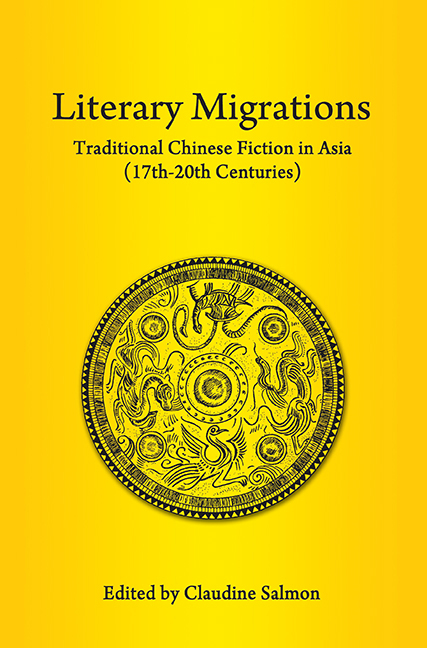Book contents
- Frontmatter
- Contents
- FOREWORD
- Dr Salmon as I Know her
- Preface to Reprint Edition
- Acknowledgements
- INTRODUCTION
- PART I KOREA AND JAPAN
- 1 The Influence of Chinese Stories and Novels on Korean Fiction
- 2 The Plots of Chinese Fiction in Korean Vernacular Novels
- 3 Chinese Colloquial Novels in Japan — Mainly during the Edo Period (1603–1867)
- PART II MAINLAND NORTHEAST ASIA
- PART III MAINLAND SOUTHEAST ASIA
- PART IV INSULAR SOUTHEAST ASIA
- Bibliography
- Author, story-teller and translator index
- Title index
- List of Plates
- Contributors
- Plate section
1 - The Influence of Chinese Stories and Novels on Korean Fiction
from PART I - KOREA AND JAPAN
Published online by Cambridge University Press: 21 October 2015
- Frontmatter
- Contents
- FOREWORD
- Dr Salmon as I Know her
- Preface to Reprint Edition
- Acknowledgements
- INTRODUCTION
- PART I KOREA AND JAPAN
- 1 The Influence of Chinese Stories and Novels on Korean Fiction
- 2 The Plots of Chinese Fiction in Korean Vernacular Novels
- 3 Chinese Colloquial Novels in Japan — Mainly during the Edo Period (1603–1867)
- PART II MAINLAND NORTHEAST ASIA
- PART III MAINLAND SOUTHEAST ASIA
- PART IV INSULAR SOUTHEAST ASIA
- Bibliography
- Author, story-teller and translator index
- Title index
- List of Plates
- Contributors
- Plate section
Summary
Comparative study of Chinese and Korean novels was first attempted by Kim T'aejun, author of Chosŏn sosŏl sa “A History of the Korean Novel” (1930), and in 1955 was taken up again in Han'guk sosŏre kkich'in chungguk sosŏrŭi yŏnghyang, “The influence of Chinese novels on Korean novels”, by Pak Sŏngui. Yi Chaesu again took up the challenge of this question in 1956. These all consistently probed the question of how influence was cast on Korean novels by such works as Sanguo zhi yanyi, “The Romance of the Three Kingdoms”, Shuihu zhuan, “The Water Margin Story”, Jian deng xinhua, “New Tales for which One Trims the Lamp”, Lienü zhuan, “Tales of Women”, Xiyou ji, “A Journey to the West”, etc.
In 1964 Chŏng Naedong proposed as a methodology that, in the comparison of Korean and Chinese novels, vocabulary, style, content and structure should be examined. Subsequently Chŏn Inch'o considered the romances of the Tang period, Yi Hyesun compared the presentation of chivalry in the works of the two countries, and Yi Nŭngu compiled a bibliography of the Sou shen ji, “Searching Out the Gods”, Taiping guangji, “Extensive Records of the Grand Tranquillity Reign”, and the “Four Great Romances” (Shuihu zhuan, Sanguo zhi yanyi, Xiyou ji and Jin Ping Mei “The Golden Lotus”). Along with these, comparative studies of individual works were also attempted. Yi Kyŏngsŏn studied origins, development and influence more deeply in Samgukchi yŏnŭiŭi pigyo munhakchŏk yŏn'gu, “A Comparative Literary Study of Sanguo zhi yanyi”, and various other discussants succeeded in probing further, but the common tendency of these publications was to study chiefly borrowing and influence on the basis of the methods proposed in “Comparative Literature” by Van Tieghem, translated by the present writer (published Sinyangsa, 1959).
- Type
- Chapter
- Information
- Literary MigrationsTraditional Chinese Fiction in Asia (17th–20th Centuries), pp. 39 - 60Publisher: ISEAS–Yusof Ishak InstitutePrint publication year: 2013



